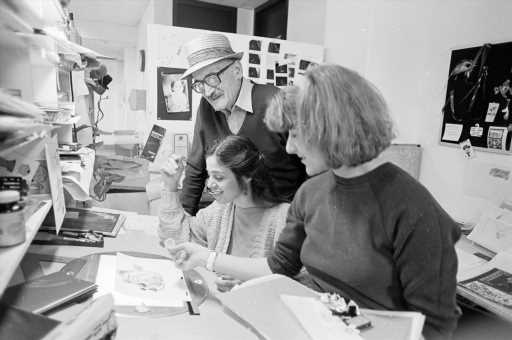For 50 years, it’s been a safe place for storytellers – musicians, animators, directors, writers, artists of all kinds – to learn, grow and thrive. As CalArts celebrates its golden anniversary, it also faces the future head-on.
Broad trustee emeritus Tim Disney, whose great-grandfather, Walt Disney, laid the foundation for what is now a world-class arts school, says that CalArts was founded with very large-scale, utopian ideas by Walt Disney. “Disneyland and CalArts were very grand things,” Disney says, adding that Walt died before the school opened and that his grandfather, Roy Disney, “had the very hard job” seeing the plans through. “His commitment was a very beautiful thing.”
It’s not a coincidence that Tim Disney spearheaded the Roy and Edna Disney CalArts Theater (RedCat) in Downtown L.A., which hosts cutting-edge performances.
“Walt Disney was inspired by CalTech. He had radical ideas about education, and wanted to create a kind of laboratory where the arts would cross-pollinate,” notes CalArts faculty member and author Janet Sarbanes, who has been doing extensive research on the school’s history. “Disney said bring me the most innovative people in their field.” She notes that Disney’s vision was “radical,” recruiting avant- garde artists from New York but always with an eye on cross-pollinating disciplines. The rich mix of artists/instructors and intellectual stimulation has seen such names as Tim Burton, Don Cheadle, Pete Docter, Genndy Tartakovsky, Katy Sagal, Allison Brie, Ravi Coltrane, Nedra Wheeler, Marcelo Zarvos and Paul Ruebens, among many others, trek its halls.
“CalArts has had an outsized impact on our society, evidenced by what the alumni have done,” says CalArts president Ravi Rajan.
Since CalArts is basically one flowing building on a tree-filled hill in Valencia, Calif., the 1400 students- and teachers – regularly engage on campus. This is the point, says jazz program director David Roitstein, founding member of the CalArts jazz program. He also praises the flexibility of the instructors and students and programs, noting that the jazz program was founded in the early 1980s with the mandate from dean of music Nicholas England – himself an expert on world music — to do it differently.
“He wanted to start this program, but he didn’t want to do it the same way as all the other schools do it, which is primarily about harmony and very linear, analytical, academic kind of thinking, you know. But jazz tradition is an oral tradition too. So he brought in Charlie Haden” the legendary bassist and composer. That sort of industry outreach is baked into the curriculum.
Innovative teaching and student engagement thrills faculty member Ellen McCartney, who teaches costume design and notes the success of such alumni as Rita Ryak, X. Hill, Lean Sands, Kate Fry and Barbara Inglehart. Storytelling through costume is the key her students learn.
“The focus of the training is on the design and the conceptual side of things,” says McCartney, adding, “It’s really the storytelling part of it. That is, why are we telling these stories, what stories are important? And all of it involves collaboration. It involves communication.”
Rajan looks forward to the next 50 years but also sees big challenges for higher education.
“We really believe strongly that aptitude is evenly distributed in the population, but opportunity is not,” he says, noting that the school will be “wrestling with that fact, and it isn’t going to be an easily solvable problem. You can’t snap your fingers and do it. But it’s built into what we’re doing. Because what we do is so personalized, with a very low student to faculty ratio — and that’s the magic.”
As for other blue-sky ideas for the next half-century, Rajan says, “There’s a lot of thinking about how we could create a lab or an institute where technology and technologists can come and work with artists and the newest things can be there and that can maybe be funded by public private partnerships.
Sounds a lot like what Walt Disney would have wanted from his school of storytellers.
Read More About:
Source: Read Full Article
